The Confirmation Model: OB + FVG + Liquidity Sweep (Smart Money Concepts)
2025-11-12 09:40:13
Most traders lose not because they can’t find setups but because they take every setup. The truth is, not all order blocks are created equal. Some are noise, others are footprints. The difference lies in confirmation.
This is where the three-layer confirmation model - Order Block (OB) + Fair Value Gap (FVG) + Liquidity Sweep - comes in.
It’s the framework that transforms your chart from a guessing game into a high-probability execution system.
The Core Idea: Precision Over Prediction
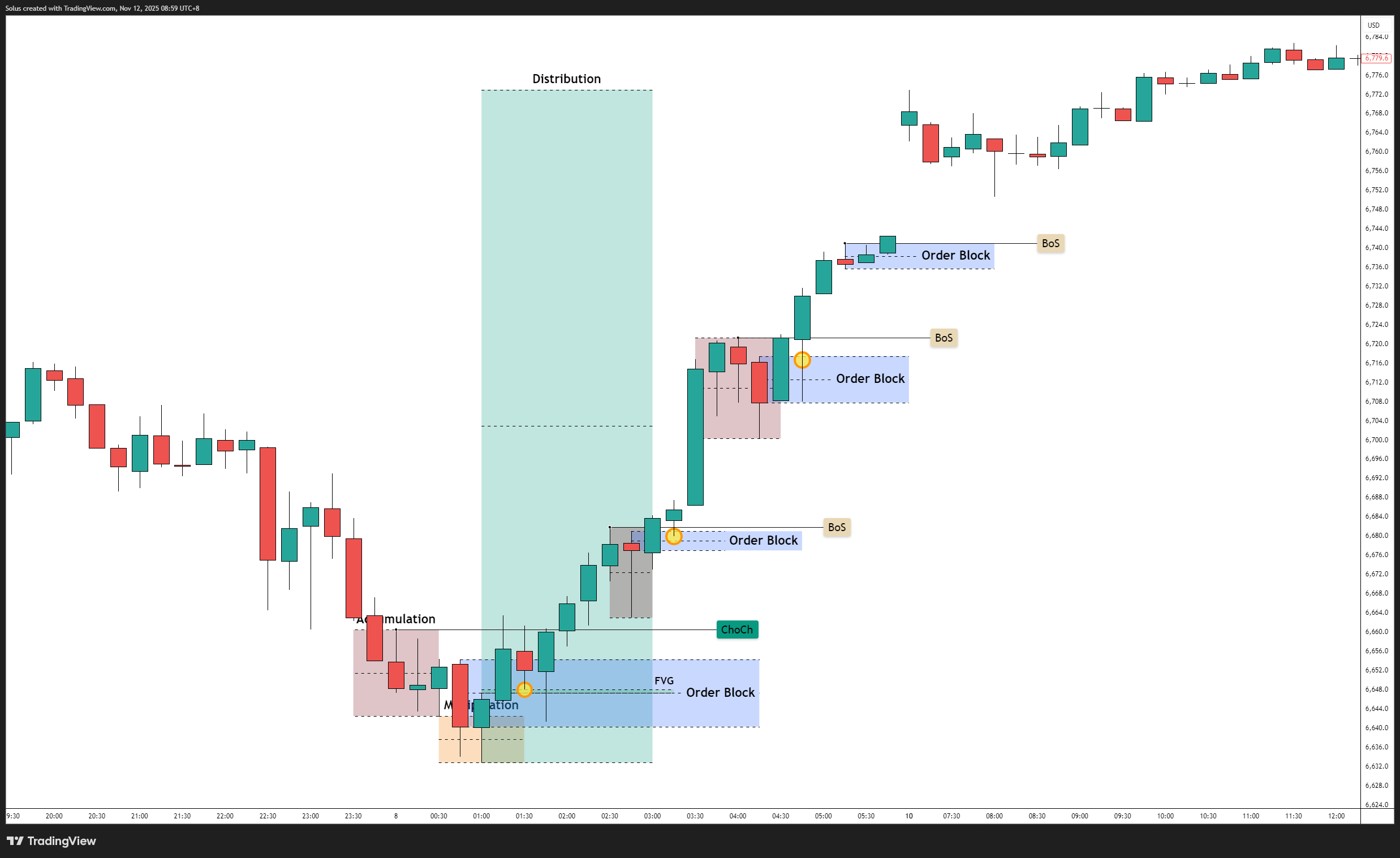
The goal isn’t to predict where price might go. It’s to wait for confirmation that the market has already made its move - and you’re stepping in with proof of institutional intent.
This confirmation model filters trades into three layers:
- Liquidity Sweep (Inducement)
- Fair Value Gap (Displacement)
- Order Block (Institutional Anchor)
When all three align, you’re no longer reacting emotionally - you’re trading systematically, in sync with the mechanics of Smart Money Concepts.
1. Liquidity Sweep - The Catalyst
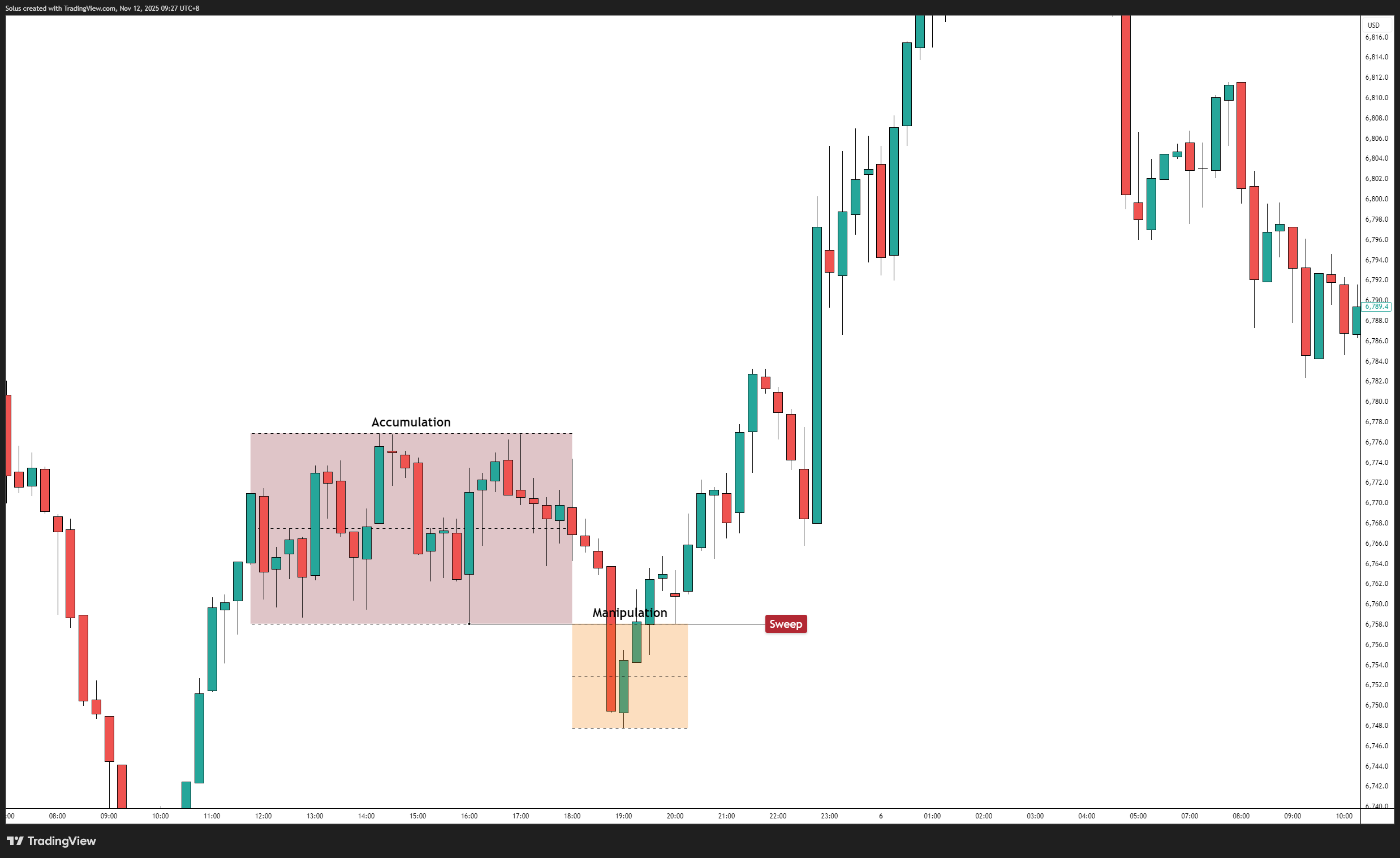
Every strong move begins with a trap. Before institutions can move price in their desired direction, they need liquidity.
This means triggering stop losses and grabbing pending orders above or below clear highs and lows - what we call inducement.
Liquidity sweeps are the fuel behind displacement.
You’ll often see price wicking above a previous high, only to reverse sharply - that’s the signature of smart money collecting liquidity before delivery.
How to recognize a liquidity sweep:
- Look for resting liquidity such as previous session high/low, internal range high/low, or equal highs/lows.
- Wait for a sweep - a strong wick that takes liquidity but fails to close beyond structure.
- Mark the manipulation point - the last candle before the reversal becomes your potential Order Block.
Once the sweep is complete, the market has taken its fuel.
Now, it’s ready to deliver.
2. Fair Value Gap (FVG) - The Displacement Proof
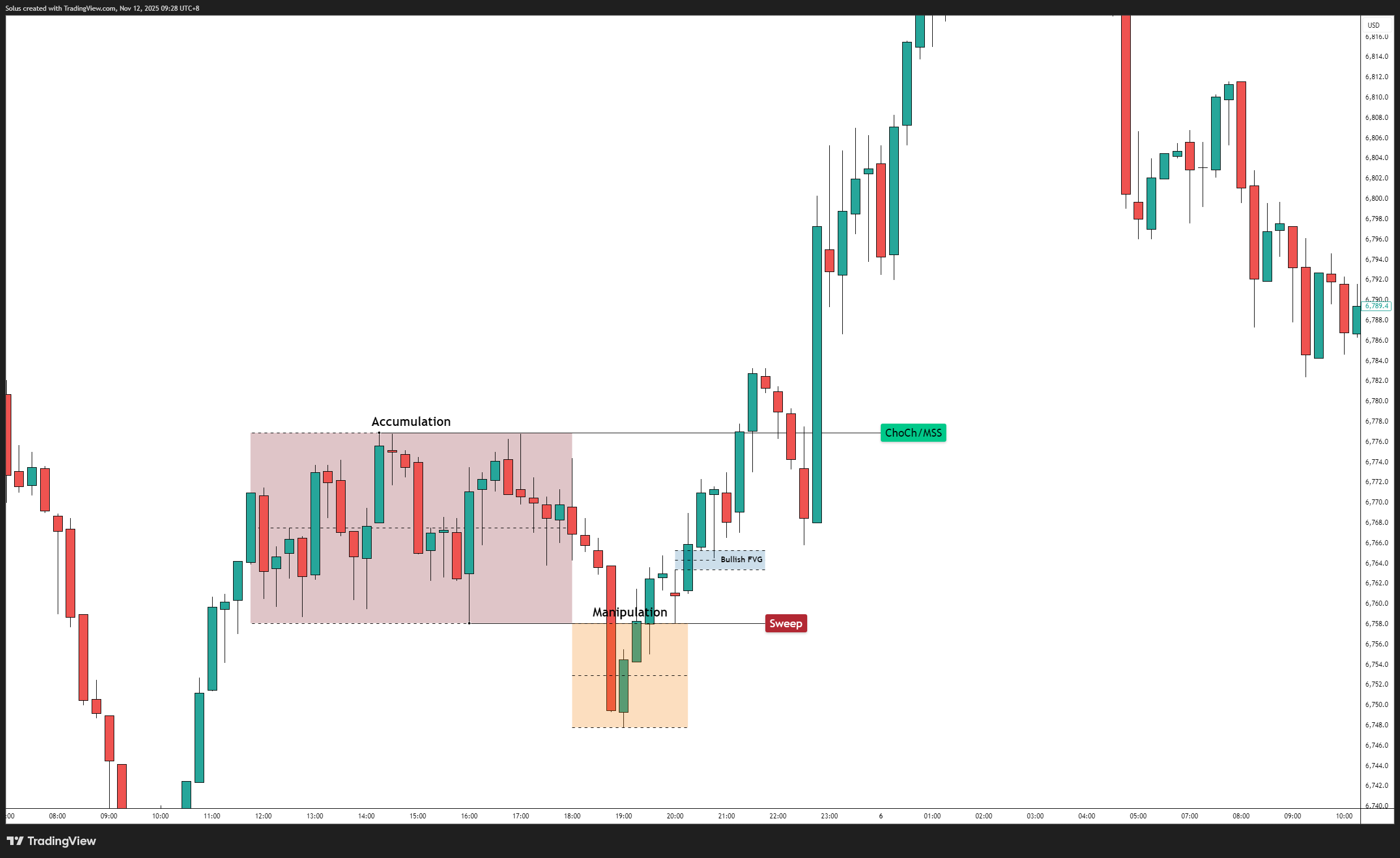
After the sweep, you’ll often see an explosive displacement - a powerful move that creates an imbalance between buyers and sellers.
That inefficiency is what we call a Fair Value Gap, which you can study deeper in Fair Value Gaps Explained.
An FVG is formed when three candles leave a void - where the middle candle’s body doesn’t overlap with the prior or next candle’s wick.
It signals that price moved so fast, orders couldn’t be matched efficiently - a footprint of institutional intent.
When price later retraces to “fill” that imbalance, it’s not random.
It’s the market rebalancing inefficiency - providing a second chance for traders to join in the direction of the displacement.
FVG Confirmation Checklist
- Occurs after a liquidity sweep (never before).
- The middle candle’s body creates a clear gap.
- The displacement breaks minor structure (BOS).
- Volume or momentum expands noticeably.
When you see a clean FVG following a liquidity sweep, that’s confirmation of intent - not speculation.
3. Order Block (OB) - The Institutional Anchor
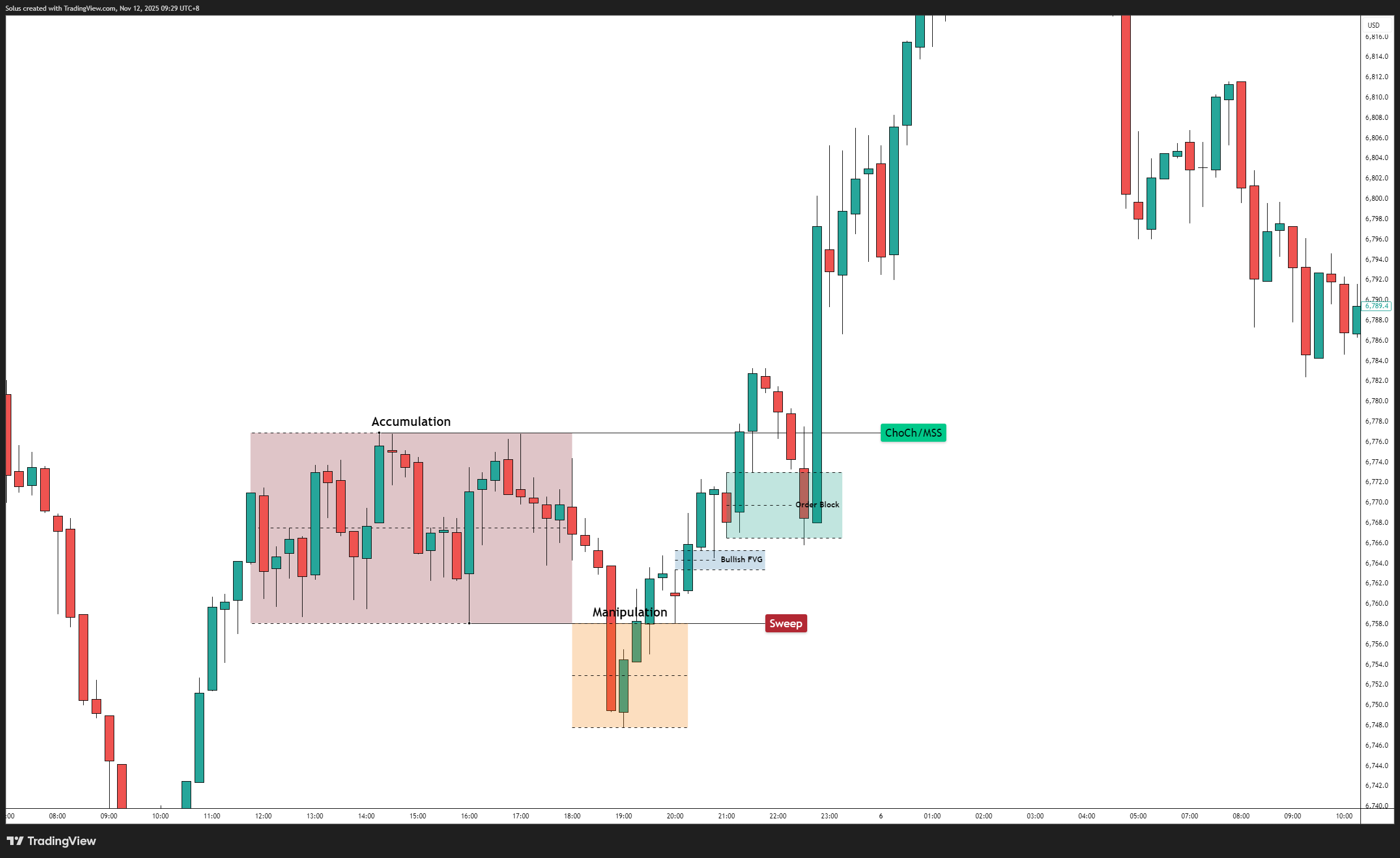
After displacement, you’ll find a decisive candle before the move - that’s the Order Block, the origin of the imbalance.
It’s where smart money executed the orders that fueled the move.
But not all OBs are valid.
The strongest OBs have confluence with both the liquidity sweep (they’re located near the inducement point) and the Fair Value Gap (the FVG overlaps or extends from the OB zone).
This OB-FVG overlap is the highest-probability setup within institutional trading - a principle refined in Anatomy of a Perfect Execution.
OB Confirmation Criteria
- The OB is the last opposing candle before the displacement.
- It sits adjacent to or overlaps with the FVG.
- The sweep has occurred immediately before displacement.
- The OB aligns with higher timeframe structure or premium/discount zones.
When price retraces into this OB-FVG zone after a sweep, it’s a controlled retest - the kind institutions use to add to positions, not retail traders guessing tops or bottoms.
How the Model Works in Sequence

To visualize it, think of the market as a three-act play.
Act 1: Inducement (The Bait)
The market sweeps liquidity - enticing breakout traders to enter in the wrong direction.
Stop-loss clusters become smart money’s entry liquidity.
Act 2: Displacement (The Punch)
Price explodes in the opposite direction, leaving an FVG.
This confirms that the sweep wasn’t random - it was a setup.
Act 3: Retracement (The Opportunity)
Price retraces into the OB-FVG overlap - the zone where institutions re-enter and deliver the next leg.
When you align all three - sweep, FVG, and OB - you’ve identified a confirmed institutional footprint.
The Confirmation Matrix - Trade Filters
Use this model as a checklist before execution.
If all boxes are checked, the trade is valid. If not, wait.
| Condition | Confirmation | Why It Matters |
|---|---|---|
| Liquidity Sweep | ✅ | Confirms inducement and traps liquidity. |
| Fair Value Gap | ✅ | Confirms displacement and institutional intent. |
| Order Block | ✅ | Defines entry zone where institutions re-engage. |
| Higher Timeframe Bias | ✅ | Confirms directional alignment. |
| Internal Confluence (e.g., EMA/FVG overlap) | Optional | Adds precision, not necessity. |
A valid trade setup should at least satisfy the first three layers. Everything else is refinement.
Confluence and the Role of Higher Timeframes
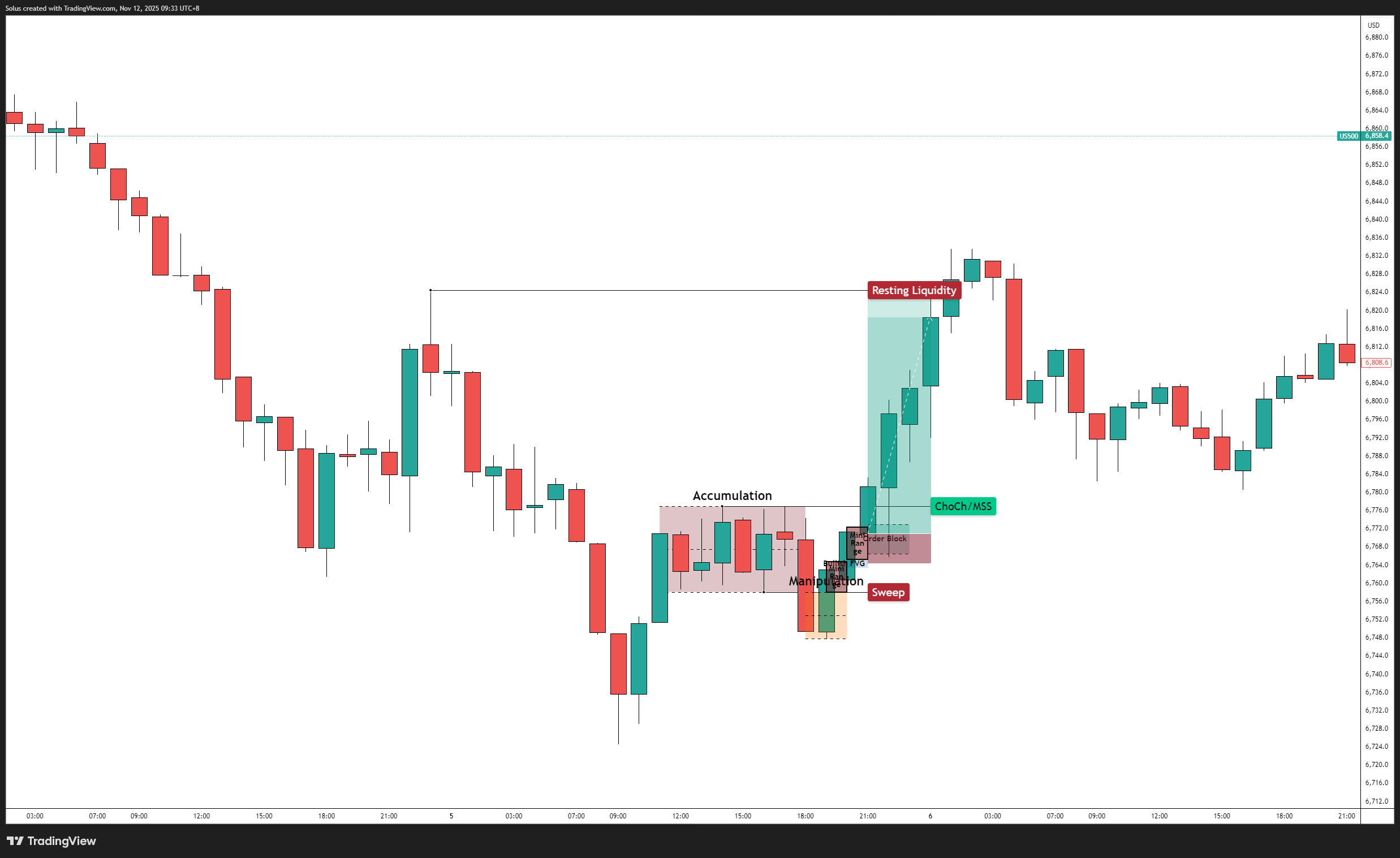
The three-layer model becomes even stronger when aligned with multi-timeframe confluence - as expanded on in The Power of Multi-Timeframe Analysis in Smart Money Concepts.
For example:
- A 4H bullish FVG gives context.
- A 15M liquidity sweep shows inducement.
- A 1M OB-FVG overlap confirms precision entry.
You’re essentially trading institutional flow with sniper accuracy - higher timeframes tell you the bias, and lower timeframes refine the entry.
Common Mistakes to Avoid
Even experienced traders can misuse this model. Here are key pitfalls:
- Entering before the sweep: If liquidity hasn’t been taken, the market hasn’t been fueled yet.
- Ignoring imbalance: Without FVG displacement, you have no proof of institutional activity.
- Overtrading internal OBs: Wait for structural confirmation - not just the candle pattern.
- Trading counter to structure: Always align entries with your higher timeframe bias.
Patience is the differentiator. The sweep-displacement-retracement cycle doesn’t occur often, but when it does, it’s precise.
Real-Life Analogy: The Chess Trap
Think of this confirmation model like a chess opening trap.
The liquidity sweep is bait - your opponent thinks they’re winning material, but they’re walking into a setup.
The displacement is the counterattack - sudden, decisive, and exposing overextension.
The order block is the checkmate position - where control and structure converge.
The trader who waits for these three confirmations plays strategically, not emotionally.
Final Thoughts
The OB-FVG-Liquidity Sweep confirmation model is how professionals separate intent from illusion.
This is not about predicting every candle. It’s about waiting for proof that smart money has moved - then following that footprint with precision and patience.
By mastering this model, you’ll filter out 80% of low-quality setups and only act when manipulation, displacement, and structure align perfectly.
Remember: patience is part of confirmation. If the market hasn’t swept, displaced, and returned - it’s not ready yet.
Once you can read this rhythm fluently, every trade will feel less like gambling and more like executing with evidence.
Start Trading Live!
- Trade forex, indices, gold, and more
- Access ACY, MT4, MT5, & Copy Trading Platforms
It’s time to go from theory to execution!
Create an Account. Start Your Live Trading Now!
Check Out My Contents:
Strategies That You Can Use
Looking for step-by-step approaches you can plug straight into the charts? Start here:
- How To Trade & Scalp Indices at the Open Using Smart Money Concepts (SMC)
- How to Trade Breakouts Effectively in Day Trading with Smart Money Concepts
- Complete Step-by-Step Guide to Day Trading Gold (XAU/USD) with Smart Money Concepts (SMC)
- The Power of Multi-Timeframe Analysis in Smart Money Concepts (SMC)
- Forex Trading Strategy for Beginners
- Mastering Candlestick Pattern Analysis with the SMC Strategy for Day Trading
- How to Use Fibonacci to Set Targets & Stops (Complete Guide)
- RSI Divergence Trading Strategy for Gold: How to Identify and Trade Trend Reversals
- Stochastics Trading Secrets: How to Time Entries in Trending Markets using Stochastics
- Gold Trading Stochastics Strategy: How to Trade Gold with 2R - 3R Targets
- RSI Hidden Divergence Explained: How to Spot Trend Continuations Like a Pro
- Moving Averages Trading Strategy Playbook
- Mastering Fibonacci Trading Psychology - Trusting the Levels, Managing the Mind
- Mastering Price Action at Key Levels - How to Spot, Trade, and Win at the Most Crucial Zones
- Mastering Retests: How to Enter with Confirmation After a Breakout
Indicators / Tools for Trading
Sharpen your edge with proven tools and frameworks:
- The Ultimate Guide to Risk Management in Trading - A Complete Compilation for 2025
- Moving Averages Trading Strategy Playbook
- How to Think Like a Price Action Trader
- Mastering Fibonacci Trading Psychology - Trusting the Levels, Managing the Mind
How To Trade News
News moves markets fast. Learn how to keep pace with SMC-based playbooks:
- Why Smart Money Concepts Work in News-Driven Markets - CPI, NFP, and More
- How to Trade NFP Using Smart Money Concepts (SMC) - A Proven Strategy for Forex Traders
- How to Trade CPI Like Smart Money - A Step-by-Step Guide Using SMC
- Learn to Trade News by Backtesting it with Forex Tester
Learn How to Trade US Indices
From NASDAQ opens to DAX trends, here’s how to approach indices like a pro:
- How to Start Trading Indices and Get into the Stock Market with Low Capital (2025 Guide)
- Best Indices to Trade for Day Traders | NASDAQ, S&P 500, DAX + Best Times to Trade Them
- How To Trade & Scalp Indices at the Open Using Smart Money Concepts (SMC)
- NAS100 - How to Trade the Nasdaq Like a Pro (Smart Money Edition)
How to Start Trading Gold
Gold remains one of the most traded assets - here’s how to approach it with confidence:
- How to Swing Trade Gold (XAU/USD) Using Smart Money Concepts: A Simple Guide for Traders
- Complete Step-by-Step Guide to Day Trading Gold (XAU/USD) with Smart Money Concepts (SMC)
- The Ultimate Guide to Backtesting and Trading Gold (XAU/USD) Using Smart Money Concepts (SMC)
- Why Gold Remains the Ultimate Security in a Shifting World
- How to Exit & Take Profits in Trading Gold Like a Pro: Using RSI, Range Breakdowns, and MAs as Your Confluence
- Backtest Gold using Forex Tester Online
How to Trade Japanese Candlesticks
Candlesticks are the building blocks of price action. Master the most powerful ones:
- Mastering the Top Japanese Candlesticks: The Top 5 Candlesticks To Trade + Top SMC Candlestick Pattern
- How to Trade Candlestick Patterns with High Probability: A Complete Guide for Beginners
- The Top Japanese Candlestick Guide: What is an Engulfing Pattern and How to Trade It?
- Piercing Pattern Candlestick Explained: How to Trade It - Step-By-Step Guide
- Morning & Evening Star Candlestick Patterns - How to Trade Market Reversals with Confidence
How to Start Day Trading
Ready to go intraday? Here’s how to build consistency step by step:
- 5 Steps to Start Day Trading: A Strategic Guide for Beginners
- 8 Steps How to Start Forex Day Trading in 2025: A Beginner’s Step-by-Step Guide
- 3 Steps to Build a Trading Routine for Consistency and Discipline - Day Trading Edition
- The Ultimate Guide to Understanding Market Trends and Price Action
- Trading with Momentum: The Best Trading Session to Trade Forex, Gold and Indices
Swing Trading 101
- Introduction to Swing Trading
- The Market Basics for Swing Trading
- Core Principles of Swing Trading
- The Technical Foundations Every Swing Trader Must Master
- Swing Trader’s Toolkit: Multi-Timeframe & Institutional Confluence
- The Psychology of Risk Management in Swing Trading
- Swing Trading Concepts To Know In Trading with Smart Money Concepts
- Becoming a Consistent Swing Trader: Trading Structure & Scaling Strategy
Learn how to navigate yourself in times of turmoil
Markets swing between calm and chaos. Learn to read risk-on vs risk-off like a pro:
- How to Identify Risk-On and Risk-Off Market Sentiment: A Complete Trader’s Guide
- How to Trade Risk-On and Risk-Off Sentiment - With Technical Confirmation
- The Ultimate Guide to Understanding Market Trends and Price Action
- Metals in Risk-On and Risk-Off Environments: How Sentiment Moves Gold and Commodities
Want to learn how to trade like the Smart Money?
Step inside the playbook of institutional traders with SMC concepts explained:
- Why Smart Money Concepts Work: The Truth Behind Liquidity and Price Action
- Mastering the Market with Smart Money Concepts: 5 Strategic Approaches
- Understanding Liquidity Sweep: How Smart Money Trades Liquidity Zones in Forex, Gold, US Indices
- The SMC Playbook Series Part 1: What Moves the Markets? Key Drivers Behind Forex, Gold & Stock Indices
- The SMC Playbook Series Part 2: How to Spot Liquidity Pools in Trading - Internal vs External Liquidity Explained
- Fair Value Gaps Explained: How Smart Money Leaves Footprints in the Market
- Accumulation, Manipulation, Distribution: The Hidden Cycle That Runs Every Market
- Institutional Order Flow - Reading the Market Through the Eyes of the Big Players
- London Session Trading Secrets: How Smart Money Sets the High & Low of the Day
- Mastering the New York Session - Smart Money Concepts Guide
- Anatomy of a Perfect Execution: How SMC Traders Trade with Precision
- Step-by-Step Trading Confirmation Guide for Precise Execution
- Execution Psychology: Turning Hesitation into Confidence
- What Is an Order Block? The Institutional Footprint Explained
- Anatomy of a Valid Order Block in Smart Money Concepts
- How to Draw Order Blocks Accurately - Day Trading Style
- Order Blocks and AMD Market Structure (Smart Money Concepts)
Master the World’s Most Popular Forex Pairs
Forex pairs aren’t created equal - some are stable, some are volatile, others tied to commodities or sessions.
- The Top 5 All-Time Best Forex Pairs to Trade
- Top Forex Pairs Beyond the Big Five
- EUR/USD: The King of Forex
- USD/JPY: The Fast Mover
- GBP/USD: The Volatile Cable
- AUD/USD: The Commodity Currency
- USD/CAD: The Oil-Backed Pair
- GBP/JPY: How to Trade The Beast
- Asian & London Session Secrets
- Mastering the New York Session
Metals Trading
- Metals Trading: Why Gold and Metals Are Rising Again
- Silver Trading: The Underdog with Dual Identity
- Gold vs Silver: Institutional Demand Breakdown Explained
- How to Day Trade Silver Like a Pro: Smart Money Tactics for XAG/USD
- Platinum & Palladium: The Quiet Power Duo of Industrial Metals
- How to Trade Metals with SMC and Fundamentals - Gold Trading Strategy
- Metals in Risk-On and Risk-Off Environments: How Sentiment Moves Gold and Commodities
- Future of Metals Market: Gold Forecast 2026 & Long-Term Commodities Outlook
Stop Hunting 101
If you’ve ever been stopped out right before the market reverses - this is why:
- Stop Hunting 101: How Swing Highs and Lows Become Liquidity Traps
- Outsmarting Stop Hunts: The Psychology Behind the Trap
- How to Lessen Risk From Stop Hunts in Trading
- How Stop Hunts Trigger Revenge Trading - Breaking the Pain Cycle
- How to Accept Stop Hunts Without Losing Discipline - Shifting From Frustration to Focus
Trading Psychology
Mindset is the deciding factor between growth and blowups. Explore these essentials:
- The Mental Game of Execution - Debunking the Common Trading Psychology
- Managing Trading Losses: Why You Can Be Wrong and Still Win Big in Trading
- The Hidden Threat in Trading: How Performance Anxiety Sabotages Your Edge
- Why 90% of Retail Traders Fail Even with Profitable Trading Strategies
- Top 10 Habits Profitable Traders Follow Daily to Stay Consistent
- Top 10 Trading Rules of the Most Successful Traders
- Top 10 Ways to Prevent Emotional Trading and Stay Disciplined in the Markets
- Why Most Traders Fail - Trading Psychology & The Hidden Mental Game
- Emotional Awareness in Trading - Naming Your Triggers
- Discipline vs. Impulse in Trading - Step-by Step Guide How to Build Control
- Trading Journal & Reflection - The Trader’s Mirror
- Overcoming FOMO & Revenge Trading in Forex - Why Patience Pays
- Risk of Ruin in Trading - Respect the Math of Survival
- Identity-Based Trading: Become Your Trading System for Consistency
- Trading Psychology: Aligning Emotions with Your System
- Mastering Fear in Trading: Turn Doubt into a Protective Signal
- Mastering Greed in Trading: Turn Ambition into Controlled Growth
- Mastering Boredom in Trading: From Restless Clicking to Patient Precision
- Mastering Doubt in Trading: Building Confidence Through Backtesting and Pattern Recognition
- Mastering Impatience in Trading: Turn Patience Into Profit
- Mastering Frustration in Trading: Turning Losses Into Lessons
- Mastering Hope in Trading: Replacing Denial With Discipline
- When to Quit on Trading - Read This!
- The Math of Compounding in Trading
- Why Daily Wins Matter More Than Big Wins
- Scaling in Trading: When & How to Increase Lot Sizes
- Why Patience in Trading Fuels the Compounding Growth
- Step-by-Step Guide on How to Manage Losses for Compounding Growth
- The Daily Habits of Profitable Traders: Building Your Compounding Routine
- Trading Edge: Definition, Misconceptions & Casino Analogy
- Finding Your Edge: From Chaos to Clarity
- Proving Your Edge: Backtesting Without Bias
- Forward Testing in Trading: How to Prove Your Edge Live
- Measuring Your Edge: Metrics That Matter
- Refining Your Edge: Iteration Without Overfitting
- The EDGE Framework: Knowing When and How to Evolve as a Trader
- Scaling Your Edge: From Small Account to Consistency
- Trading in the Zone: Execution Through Habit and Structure
- Trading in the Zone: Thinking in Probabilities
- The Inner War: Fear, Greed, and the Illusion of Control
- Detachment Discipline in Trading: How to Let Go of the Need to Be Right
- Trading Hack: Why You Keep Breaking Your Own Rules (And How to Stop)
- Trading Mindset Mastery: Building Confidence Through Data
- Flow State Trading: Entering the Zone Through Structure
- Cognitive Traps in Trading: Overconfidence, Recency Bias & Revenge Trades
- The Psychology of Risk in Trading: Fear of Loss vs Fear of Missing Out
- Self-Trust in Trading – Building Confidence from Repetition, Not Just Results
- The Zen of Trading: Becoming the Observer, Not the Reactor
Market Drivers
- Central Banks and Interest Rates: How They Move Your Trades
- Inflation & Economic Data: CPI Trading Strategy and PPI Indicator Guide
- Geopolitical Risks & Safe Havens in Trading (Gold, USD, JPY, CHF)
- Jobs, Growth & Recession Fears: NFP, GDP & Unemployment in Trading
- Commodities & Global Trade: Oil, Gold, and Forex Explained
- Market Correlations & Intermarket Analysis for Traders
Risk Management
The real edge in trading isn’t strategy - it’s how you protect your capital:
- Mastering Risk Management: Stop Loss, Take Profit, and Position Sizing
- Why Risk Management Is the Only Edge That Lasts
- How Much Should You Risk per Trade? (1%, 2%, or Less?)
- The Ultimate Risk Management Plan for Prop Firm Traders - Updated 2025
- Mastering Position Sizing: Automate or Calculate Your Risk Like a Pro
- Martingale Strategy in Trading: Compounding Power or Double-Edged Sword?
- How to Add to Winners Using Cost Averaging and Martingale Principle with Price Confirmation
- Managing Imperfect Entries in Trading - How Professionals Stay Composed
Suggested Learning Path
If you’re not sure where to start, follow this roadmap:
- Start with Trading Psychology → Build the mindset first.
- Move into Risk Management → Learn how to protect capital.
- Explore Strategies & Tools → Candlesticks, Fibonacci, MAs, Indicators.
- Apply to Assets → Gold, Indices, Forex sessions.
- Advance to Smart Money Concepts (SMC) → Learn how institutions trade.
- Specialize → Stop Hunts, News Trading, Turmoil Navigation.
This way, you’ll grow from foundation → application → mastery, instead of jumping around randomly.
Follow me for more daily market insights!
Jasper Osita - LinkedIn - FXStreet - YouTube
This content may have been written by a third party. ACY makes no representation or warranty and assumes no liability as to the accuracy or completeness of the information provided, nor any loss arising from any investment based on a recommendation, forecast or other information supplies by any third-party. This content is information only, and does not constitute financial, investment or other advice on which you can rely.
Try These Next
4 Powerful Tactics to Overcome the Most Costly Forex Mistakes
How to Master MT4 & MT5 - Tips and Tricks for Traders
The Importance of Fundamental Analysis in Forex Trading
Forex Leverage Explained: Mastering Forex Leverage in Trading & Controlling Margin
The Importance of Liquidity in Forex: A Beginner's Guide
Close All Metatrader Script: Maximise Your Trading Efficiency and Reduce Stress
Best Currency Pairs To Trade in 2025
Forex Trading Hours: Finding the Best Times to Trade FX
MetaTrader Expert Advisor - The Benefits of Algorithmic Trading and Forex EAs
Top 5 Candlestick Trading Formations Every Trader Must Know















